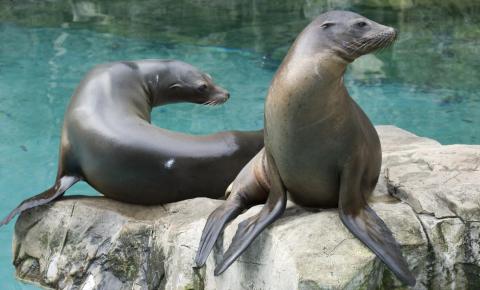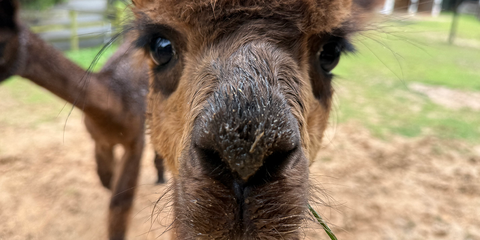The northern copperhead is a large, venomous snake found across the eastern United States in terrestrial and semiaquatic habitats. This copper-colored snake has an unmarked head and chestnut brown, hourglass-shaped crossbands along its body.
Physical Description
Copperheads are thick-bodied snakes with keeled scales. The northern copperhead has an unmarked, copper-colored head and reddish-brown, coppery body with chestnut brown crossbands. The bands are mostly hourglass-shaped, with the wider portions of the shape on either side of the snake's body and the narrower part of the shape crossing the snake's back over the tailbone.
Young copperheads are grayer in color compared to adults and have a sulfur yellow-tipped tail, which fades over time and is lost by age 3 or 4.
The northern copperhead as a vertical pupil and a single row of scales on the underside of its body after the anal plate — features also found on some venomous snakes in Virginia.
The copperhead is a pit viper and, like others pit vipers, it has heat-sensitive pit organs on each side of its head between the eye and the nostril. These pits detect objects that are warmer than the environment and enable copperheads to locate nocturnal, mammalian prey.
Copperheads have fangs that release a hemolytic venom, a venom that causes the breakdown of red blood cells, used to subdue prey. The length of the snake's fangs is related to its size — the longer the snake, the longer its fangs. Even newborn copperheads have fully functional fangs capable of injecting venom that is just as toxic as an adult's venom. This snake's fangs are replaced periodically throughout its life; each snake has a series of five to seven replacement fangs located in the gums behind and above its current fangs.
Though the copperhead is the cause of many snakebites annually, those bites are rarely fatal. They typically occur when someone accidentally touches or steps on a snake that is well camouflaged within its surroundings. When touched, the copperhead may quickly strike or remain quiet and try to slither away.
Size
The average length of an adult copperhead is between 61 and 90 centimeters (24 and 36 inches). Young copperheads are typically 18-25 centimeters (7-10 inches) long.
Copperheads are sexually dimorphic in size; females grow to greater lengths than males, but males have longer tails than females.
Native Habitat
Northern copperheads live in the United States from the Florida panhandle, north to Massachusetts and west to Nebraska. Of the five copperhead subspecies, the northern copperhead has the greatest range. It is found in northern Georgia and Alabama, north to Massachusetts and west to Illinois.
Copperheads live in a range of habitats, from terrestrial to semiaquatic, including rocky, forested hillsides and wetlands. They are also known to occupy abandoned and rotting wood or sawdust piles, construction sites and sometimes suburban areas. They climb into low bushes or trees to hunt prey and will also bask in the sun and swim in the water.
The copperhead is one of about 20 snakes native to Washington, D.C., and is the only venomous species in the area. The other venomous snake found closest to D.C. is the timber rattlesnake, which is found in Virginia, Maryland and West Virginia. Harmless snakes — such as the black rat snake, garter snake, northern water snake, ringneck snake and Dekay's or northern brown snake — are often misidentified as copperheads.
Lifespan
The life span of the copperhead is around 18 years.
Food/Eating Habits
The copperhead is a carnivore. Adults eat mostly mice but also small birds, lizards, small snakes, amphibians and insects (especially cicadas). They are primarily ambush hunters, subduing their prey with venom and swallowing it whole.
When attacking large prey, the copperhead bites and then releases immediately, allowing the venom to take effect and later tracking the prey. Smaller prey is usually held in the snake's mouth until it dies.
Young copperheads eat mostly insects, especially caterpillars, and use their yellow tipped tails to function as a worm-like lure to attract prey.
The copperhead at the Smithsonian's National Zoo eats mice and rats.
Sleep Habits
In the summer, northern copperheads are primarily nocturnal. In the spring and autumn, they are diurnal.
They hibernate over the winter, from November to April, but emerge on warmer days to bask in the sun. Their overwintering sites are south- or west-facing rock crevices and outcroppings. Pregnant females may choose wintering sites that offer warmer microclimates.
It is believed that they migrate late in the spring to reach summer feeding territories and reverse this migration in early autumn.
Social Structure
Copperheads are social snakes and may hibernate in communal dens with other copperheads, as well as other species of snakes, such as timber rattlesnakes and black rat snakes. They tend to return to the same den year after year.
These snakes can be found close to one another near denning, sunning, courting, mating, eating and drinking sites. Males are aggressive during the spring and autumn mating seasons. They will try to overpower each other and even pin each other's bodies to the ground.
This behavior is exhibited most often in front of females but is not always the case. These interactions can include elevating their bodies, swaying side to side, hooking necks and eventually intertwining their entire body length.
Reproduction and Development
These snakes reach sexual maturity at 4 years old when they are about 2 feet long. The mating season is from April to May, and a fall mating period is reported to happen in September.
During the breeding season, males seek out sexually active females using their tongues to detect pheromones in the air. Once a female is located, the male will begin moving his head or rubbing his chin on the ground. Eventually, after courtship, the male aligns his body with hers.
This courtship may last for an hour or more if the female does not respond. After being sufficiently stimulated, the female lifts and arches her tail and lowers the scale that covers her cloaca. The male then arches his body and tail, everting one of his two hemipenes, and mates with the female. Mating time ranges from 3 1/2 to 8 1/2 hours.
During the mating period, males produce a pheromone that makes the female unattractive to other males who pay little or no attention to mating or just-mated females. Females also exhibit little interest in mating after a long, successful first mating. Females can breed with more than one male.
They may also be capable of giving a "virgin" birth through a process called parthenogenesis, a form of asexual reproduction where an unfertilized egg can develop to maturity. This ability is commonly seen in invertebrates.
Females can also store sperm. Then length of time that sperm can be stored appears to differ based on where it is stored — a relatively short time if stored in the cloaca compared to a longer time if stored in the upper end of the oviducts or vascular tissues specialized as seminal receptacles. A female who breeds in autumn can store sperm until after she emerges from a hibernating state.
Copperheads have a gestation period of three to nine months. They produce large, yolk-filled eggs and store the eggs in the reproductive tract for development. During this time, the embryo survives solely on nourishment from the yolk. When carrying young, some females will not eat because the embryos take up so much space in the body cavity.
Copperheads are ovoviparous, meaning eggs develop in the body and hatch inside or immediately after being expelled. Females typically produce two to 10 young, with larger females producing larger broods. The young are expelled in a membranous sac, weighing less than 1 ounce (28 grams) and measuring about 18-25 centimeters (7-10 inches) in length at birth. The female provides no direct care for the young after birth.
Conservation Efforts
Globally, copperheads are a species of least concern, but they are listed as endangered in the state of Massachusetts and as a species of special concern in New Jersey.
Declines in this snake's population vary by location, but causes include habitat loss and degradation, collection for the pet trade, road strikes and killing by humans.
Help this Species
- Reduce, reuse and recycle — in that order! Cut back on single-use goods, and find creative ways to reuse products at the end of their life cycle. Choose recycling over trash when possible.
- Choose your pets wisely, and do your research before bringing an animal home. Exotic animals don’t always make great pets. Many require special care and live for a long time. Tropical reptiles and small mammals are often traded internationally and may be victims of the illegal pet trade. Never release animals that have been kept as pets into the wild.
- If you see a snake in the wild, leave it alone and encourage others to do the same. Don’t assume it is a venomous species, and don’t attack it if it doesn’t pose a threat to your safety. Tell your friends and family about the eco-services that snakes provide, such as keeping rodent populations in check.
- Are you a student? Did you love what you learned about this animal? Make it the topic of your next school project, or start a conservation club at your school. You'll learn even more and share the importance of saving species with classmates and teachers, too.




